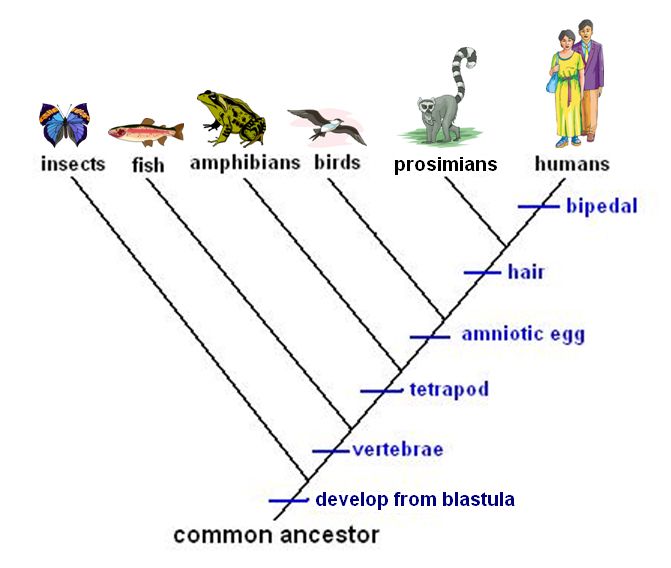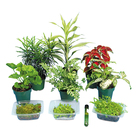Introduce Your Classroom to Classification
By Heather Ferguson
Product Developer

Introduction
With a simple set of small objects such as beads, marbles, gemstones, rocks, and/or shells, you can introduce your students to 2 basic tools of biological taxonomy—cladograms and dichotomous keys. Student pairs develop a system for classifying a group of objects on the basis of similarities and differences among them. Then, they construct a cladogram and a dichotomous key for their set of objects. This easily adapted activity is appropriate for high school students and takes only about 45 minutes to complete.
Methods of classifying organisms have evolved along with scientific understanding. Classification of living things can be traced back to Aristotle, over 2,300 years ago. He grouped organisms into plants and animals and classified animals according to their locomotion. This method of classification remained in wide use until the 1600s. As Europe’s age of exploration introduced the continent’s scientists to a seemingly endless stream of “new” organisms, interest in classification grew. In his Species Plantarum in 1753, Carolus Linnaeus established a taxonomic system of binomial nomenclature and the use of hierarchical groupings such as class and order. His methodology took hold and formed the basis of the system that remains in use. Today, species are categorized in a ranked system made up of categories of increasing inclusion from genus to family, to order, then class, phylum, kingdom, and domain.
After publication of On the Origin of Species, evolutionary relationship (phylogeny) became an important factor in classification. Rather than grouping solely on the basis of observable similarities, scientists began to consider whether similar structures were homologous (i.e., inherited from a common ancestor) before placing organisms in the same group. Clues as to homology may come from the fossil record or from an assessment of other similarities or differences that might override superficial similarities. For example, both cetaceans (whales and dolphins) and sirenians (manatees and dugongs) are mammals with adaptations for an aquatic lifestyle, such as flattened tails, front limbs modified into flippers, and insulating or buoyant blubber. Fossil evidence suggests that the specialized structures evolved independently in the 2 groups, and more recent biotechnological evidence helps confirm it.
Modern tools of molecular genomics have advanced science’s ability to determine ancestral relationships. Comparison of DNA and protein sequences among organisms provides a molecular timetable to help place points of divergence. Greater similarity in certain sequences suggests more recent common ancestry. In the case of cetaceans and sirenians, molecular evidence suggests that whales and dolphins diverged more recently from the ancestor of modern hippopotamuses than from the ancestor of manatees and dugongs. Thus, whales are said to be more closely related to hippopotamuses than to manatees.
Cladistics is a method of determining and depicting the phylogeny between organisms. A clade is a grouping that includes all the descendents of a common ancestor that share a key divergent characteristic. A cladogram illustrates a clade or clades. In the simplified cladogram that follows (which omits many groups), the organisms being compared phylogenetically are arranged at the top. The point at the base of the cladogram represents the common animal ancestor of all the organisms included on the cladogram. Early embryological development from a blastula is a shared derived character of all the animals in the cladogram. Vertebrae are a shared derived character of fish, amphibians, birds, prosimians, and humans but not of insects. If you are examining only vertebrates, then insects are considered an outgroup. On a cladogram, the more shared derived characters between 2 organisms, the more closely related the organisms are. The following cladogram shows prosimians as more closely related to birds than to insects because prosimians and birds are tetrapod vertebrates with amniotic eggs.

Figure 1 Simplified cladogram.
(illustrations ©2011 Jupiterimages Corporation)
Materials
- Student Guide
- Sets of 5 or More Small Objects (e.g., rocks, gemstones, shells, marbles, beads)
Teacher Preparation and Procedure
- Photocopy the Student Guide.
- Gather the objects. Each group should have at least 5 small objects. (It is fine for the groups to have different sorts of objects.)
- Divide the class into student pairs.
- Pass out a set of objects and a Student Guide to each pair of students.
- Before students begin the activity, consider presenting some background information about evolution, classification, and differences between historical and modern methods of classification.
- Teach your students how to construct cladograms using the information presented in the introduction.
- To teach your students how to construct a dichotomous key, use the exercise “ Teaching about dichotomous keys” found in the activity “Flower Morphology, Dichotomous Keys, and a Crime to Solve.”
After the activity, discuss problems that students encountered during the exercise. While keying out the objects, students may have noticed that other student groups named and described similar objects in different ways. This is a common problem in classical taxonomy. To correct for synonyms (2 different names given to the same organism), the earliest name given is the name that must be used. Rules for naming are outlined in international codes of nomenclature.
The Gemstone Bucket provides enough gemstones and rocks to serve as objects in this exercise. As a follow-up to this classroom activity, consider Studying Classification with Cladograms (coming soon). In this lab activity, students study the morphological features of preserved animals, perform dissections, and construct cladograms on the basis of morphological similarities.
Extension
- Discuss how this classroom activity is similar to and different from biological classification (e.g., the objects being classified are not evolutionarily related). This can lead to discussion of the ways that biologists try to determine which characteristics are shared, derived characteristics.
- Research the various codes of nomenclature that cover the major groupings of organisms.
- Visit the Web site of the Encyclopedia of Life, an ambitious, ongoing effort to catalog (and promote and protect) Earth’s biodiversity. http://www.eol.org/
- For a taste of scientific controversy, look into the PhyloCode, an effort by a group of taxonomists to overhaul the system of biological nomenclature. You can find a range of advocates—from those who seek to replace the current hierarchical system with a system that considers clades only, to those who suggest that such a change would engender bigger problems than are found in the current system, to those who suggest that the 2 systems can work in tandem. http://www.ohio.edu/phylocode/







